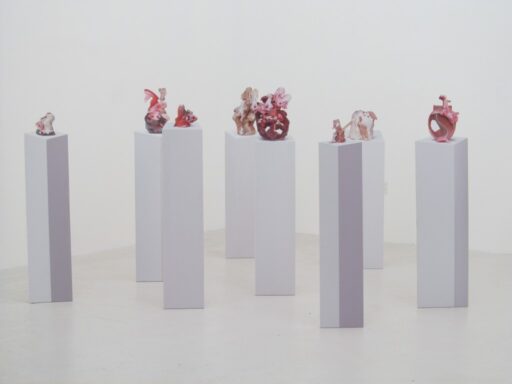Rachel de Joode’s first solo show in the United States, The Hole and the Lump at Interstate Projects, is selected as an exhibition highlight on Art F. City.
Rachel de Joode: The Hole and The Lump
By Adrian Chen, Corinna Kirsch, and Paddy Johnson
What’s on view: Lumpy clay textures printed on various flat surfaces and a room full of pink, homemade Play-Doh
Corinna: I’ve been following Rachel’s work online for a while, so I’d come into the show expecting to like it. I did.
Her work’s become more focused over the last few years, which is a good thing. There’s only so far you can go with fairly random object-pairings in a neo-classical bent. One element that’s stayed the same over time is her interest in the sculpture, bridging the 3-D/2-D divide. That makes sense with a lot of artists making work online and offline; trying to bring out the similarities and differences between the flat and the modelled.
Anyway, I love de Joode’s trompe l’oeils because she really gets sculpture. Sculpture’s supposed to be something that transforms as you move around it in space—at least the Modernist conception thereof—and and her pink, thumb-printed hybrids really force you to look up-close, far away, in the front, and behind. That’s an accomplishment.
Whitney: I see this formica-style digital putty in almost every show that translates an idea from the screen these days. People like Korakrit Arunanondchai, Letha Wilson (kinda), particularly Travess Smalley and Kate Steciw– the sensibility seems to be a common theme at galleries like Foxy Production, Ramiken Crucible, and Regina Rex. I think it has something to do with wishing you could hold a GIF. de Joode (who’s from Berlin, this is her first show in the States) does a beautiful job of this, but the genre is pretty saturated.
Adrian: This was definitely my favorite of all the things we saw. The play Corinna noted between 2-D and 3-D was great, but there was something more than just optical illusion going on. Walking into the gallery you were immediately confronted with what appeared to be a coral reef. Everything said gritty, sharp and solid. It was almost menacing. The blobby tromp l’oeils are literally on pedestals, like marble busts. Of course on closer inspection it was all flat and printed on wood and paper. I gather from Whitney this is a rather tired technique in art. But de Joode not only masters it, she hilariously acknowledges whatever may be its weaknesses. This comes from my favorite bit, a small tableau in the corner that was easily missed: There’s a photo of two figures draped in colorful blankets that had been printed to look like textured clay (the same ones that were hanging on the wall in the gallery). The strange, colorful picture is crushed awkwardly between two plain cement cinder blocks. They seemed to have fallen from the ceiling, harsh reality crashing in on the art: “You think you’re clever? Here’s what real stone can do.” *smash* Rock beats paper in the real world.


